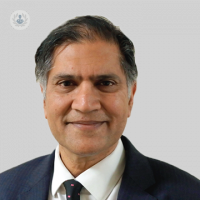Popping, clicking or crackling in the ear
Escrito por:Everyone has popping or crackling in the ear at some point, but for some people this can become quite disturbing and bothersome, affecting their quality of life, daily tasks and ability to sleep. Many conditions can cause this and in this article, Professor Manohar Bance outlines a few from his experience and practice.

Eustachian tube (ET) problems
Many people have crackling in the ear when they swallow, and this is normal. This is from the movement and opening of the Eustachian tube (ET). The ET is a complex tube that opens on swallowing to let air into the middle ear from the back of the throat. This is quite normal.
After a cold or flu, if the eustachian tube is inflamed by allergies, or if adenoids are abutting against the ET, these noises can become exacerbated and louder. The back of the throat can be examined with a camera to see if there are any obvious obstructions to the eustachian tube, but inflammation inside the tube itself is very difficult to detect. The sounds can be from pressure changes inside the middle ear from the eustachian tube opening, or from the sound of the ET opening itself.
Sometimes making a small hole in the eardrum (a myringotomy ) can tell if sounds are due to pressure changes, as the hole equalizes pressure. If this helps, a grommet can be inserted, which is a more permanent hole in the eardrum.
Other times, a short course of steroids may be used to reduce inflammation. Some people become sensitized to normal sounds of swallowing and may need psychological counselling to deal with this.
Muscular contraction problems
There are two small muscles in the middle ear, the tensor tympani and the stapes. These can sometimes go into spasms where they contract rhythmically, in which case a person may hear a “butterfly fluttering” type of sound. Sometimes these muscles contract unpredictably every few seconds or so, with good and bad times throughout the day or week. This can be annoying and disturb sleep.
It’s difficult to tell which muscle is causing the problem, but a stethoscope can be used to listen to the ear and tympanometry to measure the change in pressure as the muscle contracts (which can also sometimes tell which muscle is involved). Treatment for contraction is again difficult and can involve muscle relaxants, but if severe, these muscles can be cut with surgery to relieve the noises.
Palatal myoclonus
This is another troublesome condition where the palate muscles (which are connected to the Eustachian tube opening muscles and the middle ear muscles) start having rhythmic contractions, causing noises in the ear. A small camera through the nose can check for this. If found, an MRI scan is warranted, as sometimes (not often) it is caused by a serious brainstem neurological condition. This condition can sometimes be treated with Botox injections into the palate.
Temporomandibular joint (TMJ) problems
The TMJ is the jaw joint that has a cartilage disk in it. With ageing and wear and tear from dental conditions, this joint can degenerate and start clicking on opening and closing the mouth. In this case, you would be referred to a dental specialist.
Eardrum problems
Occasionally, crackling and popping are due to hairs or wax sitting on the eardrum, which is easy to check for and remove. Much more rarely, it is due to a trapped live insect that is moving around, which is more common in warmer climates. Again, this is rare but easy to check for.
As you can see, a crackling ear isn’t always an easy symptom to get to the bottom of and needs careful examination to point to the right course of treatment.
For more information about ear problems, check out more articles by Professor Bance on his Top Doctors profile.
Relevant Publications by Professor Bance:
Wickens B, Floyd D, Bance M. Audiometric findings with voluntary tensor
tympani contraction. J Otolaryngol Head Neck Surg. 2017 Jan 5;46(1):2. doi:
10.1186/s40463-016-0182-y. PubMed PMID: 28057076; PubMed Central PMCID:
Aron M, Floyd D, Bance M. Voluntary eardrum movement: a marker for tensor
tympani contraction? Otol Neurotol. 2015 Feb;36(2):373-81. doi:
10.1097/MAO.0000000000000382. PubMed PMID: 24751734.
Bance M, Makki FM, Garland P, Alian WA, van Wijhe RG, Savage J. Effects of
tensor tympani muscle contraction on the middle ear and markers of a contracted
muscle. Laryngoscope. 2013 Apr;123(4):1021-7. doi: 10.1002/lary.23711. Epub 2012


